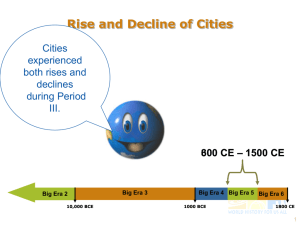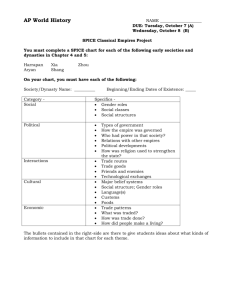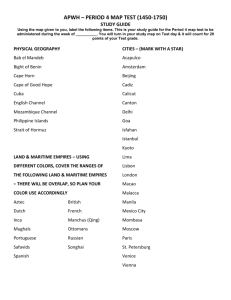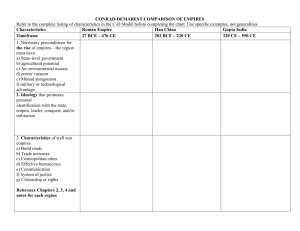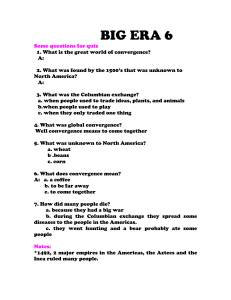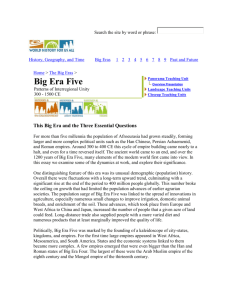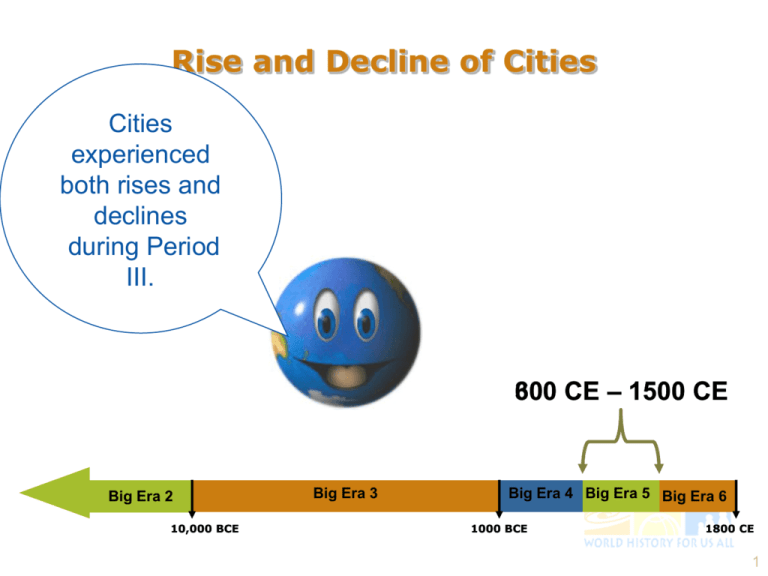
Rise and Decline of Cities
Cities
experienced
both rises and
declines
during Period
III.
300 CE – 1500 CE
600
Big Era 2
10,000 BCE
Big Era 3
Big Era 4 Big Era 5 Big Era 6
1000 BCE
1800 CE
1
Microsoft®Encarta®Reference Library 2002. ©1993-2001 Microsoft Corporation. All rights reserved.
During Period III, many connections
were established among regions. These
formed interregional patterns of unity.
2
At the start of Period III,
numerous inventions,
trade goods, and ideas
were starting to spread
from their regions of
origin.
3
…That spread of
ideas and things is
part of cultural
exchange. This
allowed cities of
the period to rise
as well as decline.
4
Cultural exchange had many aspects.
Population increased
and people migrated.
People shared ideas
across regions.
Trade networks expanded
and cities grew.
Huge empires brought many
different groups of people
together.
5
Let’s take a closer
look at each of
these causes of the
growth and decline
of cities.
Population
Trade
Ideas
Empires
6
Population
World
population
grew from
about
250 million to
460 million
between
200 CE
and 1500 CE.
The dip in the
1300s was
Sometimes interregional exchanges
due to the
allowed disease to spread, as well as
Bubonic
more helpful things.
Plague.
7
Let’s look at
Population cultural
interactions in
Afroeurasia and
see how they
impacted cities!
Microsoft®Encarta®Reference Library 2002. ©1993-2001 Microsoft Corporation. All rights reserved.
8
Population growth in Afroeurasia
affected the environment.
Population
Deforestation happened when
cities and farming expanded.
9
Population
• Wood was
insufficient for heat,
construction, and
metal-working.
• Soil eroded and
degraded.
• River flooding
devastated villages,
farmlands, and
cities.
• Famines meant
people didn’t get
enough to eat.
Human impact on the
environment had serious
effects on the ability of
cities to grow. In fact,
sometimes, it caused
them to shrink.
10
Population
Population increases and the
effects on the environment
sometimes meant that new cities
were founded. Sometimes,
people got up and moved on to
new lands.
Large groups of
people moved
around, or
migrated.
11
Vikings
Population
Mongols
Germanic
Tribes
Turkic
Groups
Chinese
Arabs
Bantu-Speaking
People of Africa
People of
Oceania
People migrated to new
places in (and out) of
Afroeurasia.
12
Population
• Migrating groups moved
into other groups’
territories, forcing them
to go elsewhere.
• Migrating groups
introduced new plants
and animals into their
new homes.
Migrations
encouraged new
cities and also put
stresses on old
cities.
• Migrations diffused
technologies for farming,
warfare, and crafts.
• Migrations diffused
languages, styles of
living, and arts.
13
Empires
Building states and
empires caused
declines in cities for a
time, then, stability
allowed cities to
flourish.
During Period III,
many, many states
and empires came…
and went.
14
Empires
New ruling groups
built on the
foundations of
earlier states and
empires.
15
Frankish
Kingdoms
Avar Kingdom
Parhae
Byzantine Empire
Sassanid
Empire
Sui China
Silla
Yamoto
Japan
Harsha’ Empire
Chalukya
Ghana
Axum
States and Empires in 600 CE
16
Carolingian
Parhae
Byzantine
Cordoba
Caliphate
Abbasid
Caliphate
GurjaraPratihara
Tang China
Silla
Heian
Japan
Ghana
Axum
Srivijaya
States and Empires in 800 CE
17
Scandanavian
Kingdoms
Russia
England
France
Spain
H.R.E.
Poland
Mongol Empire
Hungary
Rum
Portugal Almohad
Caliphate Ayyubid
Caliphate
Koryo
Delhi
Sultanate
Sung
China
Kamakura
Japan
Mali
Ethiopia
Oyo
Angkor
Benin
Zimbabwe
States and Empires in 1237 CE
18
Union of Kalmar
Russian
States
Scotland
England
France
Portugal
PolandKhanate of the
Holy
Lithuania Golden Horde
Roman
Empire Hungary
Castile
Jagatai
Khanate
Ottoman Emp.
Timurid Empire
Granada
Marinids Hafsids
Korea
Ming
China
Ashikaga
Japan
Mamluk
Sultanate
Mali
Oyo Benin
Ethiopia
Vijayanagara
Zanj City-States
Siam
Majapahit
Zimbabwe
States and Empires in 1400 CE
19
Empires
How did states
and empires
stimulate the
growth of cities in
Afroeurasia?
• Wars led to
destruction but
produced new
inventions.
• Strong governments
protected trade
routes and stabilized
currencies.
• Royal courts were
patrons of science,
religious institutions,
and arts.
• Large states brought
together many
ethnic, language, and
religious groups.
20
Trade
Trade was also
closely linked to
cultural exchange
and the growth of
cities.
Empires supported
trade in
Afroeurasia.
Merchants traveled
great distances in
search of wealth.
21
Trade
The number of cities grew, as
well as trade networks between
them.
22
Trade
Microsoft®Encarta®Reference Library 2002. ©1993-2001 Microsoft Corporation. All rights reserved.
From 600-1500 CE, trade routes extended
farther and were used by more travelers.
23
• Trade helped spread
religions, languages,
ideas, and arts.
Trade
How did expanding trade
networks bring about
positive change for cities
in Afroeurasia?
• Trade stimulated
use of natural
resources.
• Cities and
manufacturing
centers grew bigger.
• Banks, credit, and
money systems
encouraged regional
and long distance
trade.
24
Ideas
What inventions,
technologies,
products, and ideas
were exchanged
across Afroeurasia?
25
Transport and communication
technologies improved.
Ideas
Sternrudder
Lateen sail
Books & paper
North Arabian
camel saddle
Stirrup
Mapmakin
g
Astrolabe
26
Water & energy technologies were
transferred across Afroeurasia.
Ideas
• Hydraulic systems
carried water where
expanding cities
needed it.
• Wheels lifted water
to irrigate crops and
drain swamps.
• Waterwheels,
windmills, and triphammers provided
energy for pumping,
grinding, milling, and
pounding.
27
Ideas
Crops also diffused across
Afroeurasia. Travelers and
migrants introduced plants into
new regions. People began to
grow, eat, and sell these crops.
28
Ideas
• Citrus fruits rolled from
Southwest Asia to Spain,
celebrated in garden and
song.
• Cane sugar sweetened a
path from India to the
Mediterranean.
• Cotton wove its way from
India to North Africa,
Central Asia, and China.
29
Ideas
• The pace of innovation
increased.
• Knowledge
accumulated more
quickly.
• Manufacturing and
farming productivity
increased.
• People’s diets and
health improved.
• Sea travel and
transport webs became
thicker.
How did transfers of
technology and
products allow cities to
grow?
30

